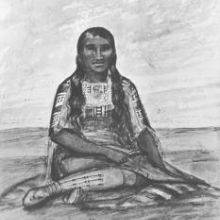Myths and Misconceptions: the Indian Princess Stereotype
We've already run across two women who've often been called Indian Princesses. Owl Woman of the Cheyenne, daughter of a Cheyenne chief and wife of William Bent. Also Adeline, daughter of Chief Seattle of the Duwamish/Suquamish. These were strong, capable women, respected by Natives and Whites alike, and we'll meet many more of them in future posts, but none of them were princesses. The wives and daughters of chiefs did not bear titles. There was no such thing as a Native royal family. With some exceptions, the only women who carried any type of position or authority in a village were the clan matriarchs. They could, in some tribes, choose and depose chiefs, veto actions of the council, or dispose of property and prisoners. For these reasons, women often carried great authority in their tribes and could be perceived by outsiders as queens or princesses, but they weren't.
The Indian Princess stereotype began in the nineteenth century with Longfellow's poems, or other novels, plays and poems describing how a beautiful Indian maiden named Pocahontas threw herself on top of an English adventurer named John Smith and begged for his life. Whether she did or didn't is a topic for another blog. The fact is that this beautiful maiden got more buxom and more royal every time her story was told. The same went for Minnehaha, the fictionalized wife of the Iroquois leader Hiawatha, and the nameless daughter of Shenandoah, a real Oneida chief. The stereotype perpetuates in fantasy art depictions of curvaceous Native women wielding bows, wearing war bonnets and commanding the elements of nature. More on war bonnets later, but suffice it to say that such women do not exist. Today, the only Indian princesses around are those who are chosen by their tribe to represent them in pageants.
'But I've always been told great-grandma was a (insert tribe) princess.' You may have had a Native woman in your ancestry. She may have been documented as being of a certain tribe. If she were lucky, she was someone like Nancy Ward, the last War Woman of the Cherokee and one of the few women who did hold an official title in their tribe. More likely, she was a hardy, industrious woman who managed her family and her property and tried to survive as best she could. Princess, no. Worthy of respect, yes. Worthy of researching the facts about who she really was.
The Indian Princess stereotype began in the nineteenth century with Longfellow's poems, or other novels, plays and poems describing how a beautiful Indian maiden named Pocahontas threw herself on top of an English adventurer named John Smith and begged for his life. Whether she did or didn't is a topic for another blog. The fact is that this beautiful maiden got more buxom and more royal every time her story was told. The same went for Minnehaha, the fictionalized wife of the Iroquois leader Hiawatha, and the nameless daughter of Shenandoah, a real Oneida chief. The stereotype perpetuates in fantasy art depictions of curvaceous Native women wielding bows, wearing war bonnets and commanding the elements of nature. More on war bonnets later, but suffice it to say that such women do not exist. Today, the only Indian princesses around are those who are chosen by their tribe to represent them in pageants.
'But I've always been told great-grandma was a (insert tribe) princess.' You may have had a Native woman in your ancestry. She may have been documented as being of a certain tribe. If she were lucky, she was someone like Nancy Ward, the last War Woman of the Cherokee and one of the few women who did hold an official title in their tribe. More likely, she was a hardy, industrious woman who managed her family and her property and tried to survive as best she could. Princess, no. Worthy of respect, yes. Worthy of researching the facts about who she really was.




Comments
Post a Comment